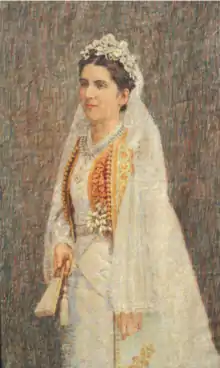Princess Zorka of Montenegro
Princess Zorka of Montenegro (Cyrillic: Кнегиња црногорска Зорка; 23 December 1864 – 16 March 1890) was the eldest child of the Montenegrin monarch Nicholas I and his wife Milena. Her name and title at birth was Ljubica Petrović-Njegoš, Princess of Montenegro.
| Princess Zorka | |||||
|---|---|---|---|---|---|
 | |||||
| Born | Ljubica Petrović-Njegoš 23 December 1864 Cetinje, Montenegro | ||||
| Died | 16 March 1890 (aged 25) Cetinje, Montenegro | ||||
| Burial | |||||
| Spouse | |||||
| Issue |
| ||||
| |||||
| House | Petrović-Njegoš | ||||
| Father | Nicholas I of Montenegro | ||||
| Mother | Milena of Montenegro | ||||
In 1883, she married prince Peter Karađorđević and she changed her name to Zorka (and her surname to Karađorđević). She died in childbirth while giving birth to Prince Andrija on 16 March 1890. Prince Andrija died shortly thereafter.
Her husband Prince Peter went on to become King of Serbia in 1903, thirteen years after her death.
Life
Born in Cetinje, Montenegro at the time when her father was already the reigning Prince of Montenegro (his uncle Danilo II Petrović-Njegoš having died in 1860). She had eight younger sisters and three younger brothers. Zorka was educated in Russia before returning to Montenegro to be engaged to Karađorđević. Zorka's sister Elena married the future King Victor Emmanuel III of Italy.
Marriage and children

Described as "exuberant" by one commentator, Zorka married Peter in Cetinje on 1 August 1883 in an Orthodox ceremony.[1]
They had five children:
- Princess Helen of Serbia (4 November 1884 – 16 October 1962).
- Princess Milena of Serbia (28 April 1886 – 21 December 1887).
- George, Crown Prince of Serbia (8 September 1887 – 17 October 1972).
- Alexander I of Yugoslavia (16 December 1888 – 9 October 1934).
- Prince Andrew of Serbia (born and died 16 March 1890).
Death
Zorka died aged just 25 on 16 March 1890 in Cetinje during childbirth and was buried in the St. George's Church in Topola, Serbia.
Monument
The first monument for a woman in Serbia was erected for Zorka on 3 June 1926. The monument, a work of sculptor Stamenko Đurđević, was funded by the Duchess Zorka Society and was located on the Big Kalemegdan. The monument was removed and probably destroyed after World War II. The gypsum model of the monument has survived and is housed in the History Museum of Serbia.[2]
References
- The Times, "Montenegro", 13 August 1883.
- Mučibabić, D. (2013-06-14). "Search for the lost sculptures from Belgrade fortress". Politika. Retrieved 2016-12-28.
External links
- Royal Mausoleum Oplenac
- The Njegoskij Fund Public Project : Private family archives-based digital documentary fund focused on history and culture of Royal Montenegro.
| Wikimedia Commons has media related to Princess Zorka of Montenegro. |